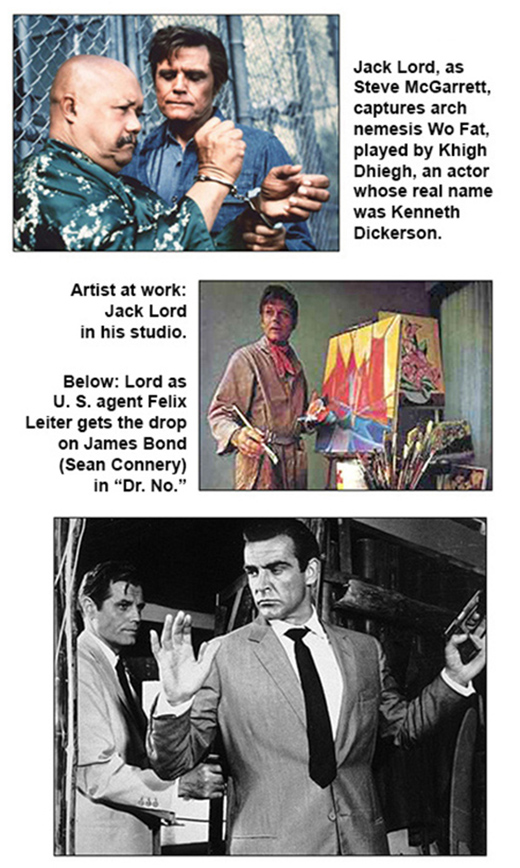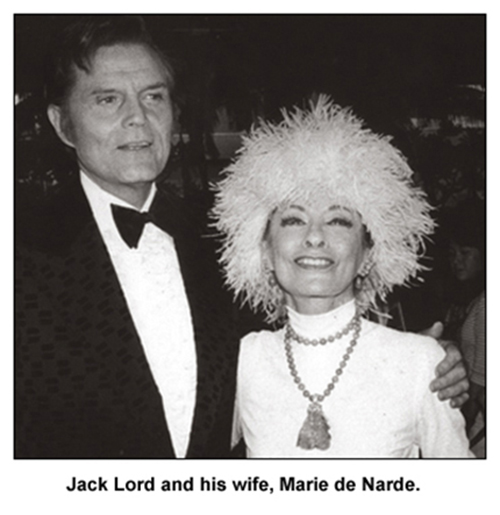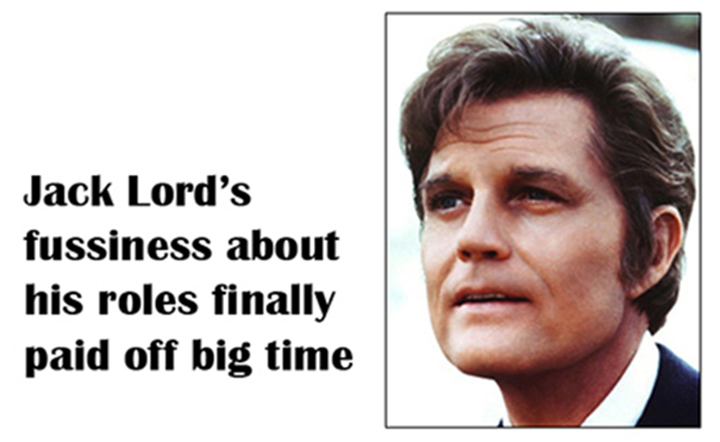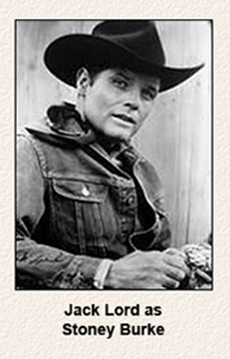| HOME |
 |
|
|
"Hawaii Five-O" was one of the biggest hits in television history. After all, only the great ones return to life, albeit with a new cast, a contemporary setting, crime-fighting tools that would have made Steve McGarrett's head swim, and enhanced cinematography that makes our island state more lush and beautiful than it looked the first time around. However, a story written after a phone interview with Jack Lord in 1969 reminded me that "Hawaii Five-O" was lucky to have survived its first season (1968-69). Its escape from cancellation didn't rival the nail-biting adventure of "The Dick Van Dyke Show" a few years earlier, but it came close. |
|
|
|
What wasn't mentioned — because at the time I hadn't noticed it — was one noticeable change that had been made to "Hawaii Five-O" between the time the pilot was filmed and the series went into production. The characters were toned down. Hawaiian shirts gave way to suits. Chin Ho Kelly (Kam Fong), one of Steve McGarrett's detectives, suddenly was subdued, rather than the upbeat extrovert he was in the pilot. Likely this change was initiated by Lord after he took a good, long look at the pilot. The 1969 interview was one of four I had with the actor. Our first meeting was face-to-face when he showed up in Cleveland in 1962 to promote his first series, "Stoney Burke," about a rodeo rider. On his publicity Lord showed up for all his interviews dressed in a cowboy outfit . He was living his role as Stoney. My story said, in part: |
|
|
|
As was mentioned in the first story, "Stoney Burke" was canceled after one season and 32 episodes. That's right, 32. Television seasons were longer back then. The thinking was a series had to run at least three seasons to accumulate enough episodes to be marketable in syndication where the real money was made. However, even one season's worth of episodes was enough to provide Lord with extra income for several years after "Stoney Burke" was canceled. Lord was a serious man, dedicated to his work, whether it was acting or painting. He was born John Joseph Patrick Ryan in 1920, and his career was delayed by World War II when he served first in the U. S. Army Corps of Engineers and later with the Merchant Marines. He was a bit older and a lot wiser than most actors, and plotted each move very carefully. For awhile it appeared he might be too fussy, but his insistence upon getting a piece of the action eventually paid off. Lord made his first movie appearance in 1949 in something called "Project X," a suspense tale about Communist infiltration in the United States. The film was made in New York City where Lord was studying acting with Sanford Meisner. In the 1950s he worked mostly on the Broadway stage. Among his roles was Brick in "Cat on Hot Tin Roof." He succeeded Ben Gazzara in the role. In 1955 he played Elizabeth Montgomery's husband in the Gary Cooper film, "The Court-Martial of Billy Mitchell." After two films in 1958, "God's Little Acres" and another Cooper film, "Man of he West," Lord's on-camera performances were mostly for the small screen. Among them were two guest roles on "Rawhide" and one each on "Naked City" and "Route 66." People in the business were impressed with his work and started offering him lead roles in television series. Lord said he turned down 22 series before he agreed to do "Stoney Burke." After that show was canceled he received more offers, including "The Man from UNCLE," which later went to Robert Vaughn. Most interesting, perhaps, is that Lord was asked to play Capt. James Kirk in "Star Trek" in place of Jeffrey Hunter, who starred in the series pilot film. Lord wanted co-producer status and part ownership in the series, prompting creator Gene Roddenberry to withdraw the offer. Meanwhile, he also laid down unacceptable conditions to reprise the role of U. S. agent Felix Leiter in "Goldfinger." Lord originated the role in the first James Bond film, "Dr. No," released in 1962, the same year he began "Stoney Burke." Lord asked to be listed as co-star of "Goldfinger," with Leiter's part greatly expanded. No deal, the producers replied. As mentioned in the 1969 story above, Lord did a pilot for a Western called "Cutter's Trail" before he moved into "Hawaii Five-O." The script for "Cutter's Way" was rewritten a few times and finally made as another pilot, this time starring John Gavin. It never became a series, but was shown as a CBS movie. In 1972, after "Hawaii Five-O" had become a big hit, Lord hit the phone interview circuit again. I've lost the story that came out of that conversation, so I don't know what his concerns might have been. In 1975, when I had my final interview with Lord, he was upset that CBS had moved his show from Tuesday nights, where it was very popular, to Friday nights where it was being beaten regularly by NBC's "The Rockford Files." A month after the call, CBS gave in to Lord's request and moved the show again, this time to Thursdays, and the ratings went up. There were other things on Lord's mind in '75. For one thing, he still liked to talk about "Stoney Burke." "If ABC had had more guts at the time, that show would still be on the air," said Lord. "Stoney was a peaceful hero in a violent setting, a man way ahead of his time on television. And look at the other actors on that series – Warren Oates and Bruce Dern. Look at how far they've come since then." On the other hand, Lord's Steve McGarrett of "Hawaii Five-O" was the central figure in a very violent program. Lord admitted there was violence, but thought it was appropriate for "Hawaii Five-O." He was annoyed by a certain U. S. Senator from Rhode Island (John Pastore), though he didn't mention him by name "It was that loud mouth from Rhode Island who started all this fuss about violence on television. I even wrote him a letter and told him he had found a great way to grab a headline. I see he's retiring, and that's good. But I suppose some other politician will come along and jump on television as a way to attract attention. " 'Hawaii Five-O' is genuine action, a reflection of what goes on in our world. But remember, every one of our episodes makes the point, sometimes subtly, sometimes overtly, that crime doesn't pay. And I can tell by the mail we receive that our viewers are getting that message and they appreciate it." However, Lord was not willing to give the letter writers something that a lot of them wanted – more up close and personal information about Steve McGarrett, whose private life was a deep, dark secret on the series. "People want to know more about what McGarrett's home life is like, what he does when he is home. But even if we chose to reveal that, I don't think we could match what our viewers have built up in their heads over the past seven years. "Besides, I think the enigma of McGarrett is good. It intrigues the hell out of people." |
|
 |
|
Lord's "Hawaii Five-O" ran for 12 seasons, leaving the network in 1980. Lord and his wife, fashion designer Marie de Narde, were firmly settled in Hawaii by this time and lived out their lives there. Lord was ill for several years before his death in 1998. His wife died seven years later. Their entire estate, worth $40 million, was willed to a dozen Hawaii charities. |
|
 |
|
|
|
| HOME • STARSTRUCK • CONTACT |

 When he teamed with producer Leslie Stevens last spring to invent rodeo rider Stoney Burke, Lord set out to create a person different from anyone he had ever met. Someone had to give ... and it was Lord, who changed his ways to fit the Stoney Burke image.
When he teamed with producer Leslie Stevens last spring to invent rodeo rider Stoney Burke, Lord set out to create a person different from anyone he had ever met. Someone had to give ... and it was Lord, who changed his ways to fit the Stoney Burke image.